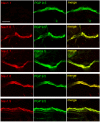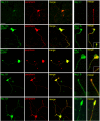Sodium-calcium exchanger and multiple sodium channel isoforms in intra-epidermal nerve terminals
- PMID: 21118538
- PMCID: PMC3002896
- DOI: 10.1186/1744-8069-6-84
Sodium-calcium exchanger and multiple sodium channel isoforms in intra-epidermal nerve terminals
Abstract
Background: Nociception requires transduction and impulse electrogenesis in nerve fibers which innervate the body surface, including the skin. However, the molecular substrates for transduction and action potential initiation in nociceptors are incompletely understood. In this study, we examined the expression and distribution of Na+/Ca2+ exchanger (NCX) and voltage-gated sodium channel isoforms in intra-epidermal free nerve terminals.
Results: Small diameter DRG neurons exhibited robust NCX2, but not NCX1 or NCX3 immunolabeling, and virtually all PGP 9.5-positive intra-epidermal free nerve terminals displayed NCX2 immunoreactivity. Sodium channel NaV1.1 was not detectable in free nerve endings. In contrast, the majority of nerve terminals displayed detectable levels of expression of NaV1.6, NaV1.7, NaV1.8 and NaV1.9. Sodium channel immunoreactivity in the free nerve endings extended from the dermal boundary to the terminal tip. A similar pattern of NCX and sodium channel immunolabeling was observed in DRG neurons in vitro.
Conclusions: NCX2, as well as NaV1.6, NaV1.7, NaV1.8 and NaV1.9, are present in most intra-epidermal free nerve endings. The presence of NCX2, together with multiple sodium channel isoforms, in free nerve endings may have important functional implications.
Figures








References
Publication types
MeSH terms
Substances
LinkOut - more resources
Full Text Sources
Other Literature Sources
Molecular Biology Databases
Miscellaneous

